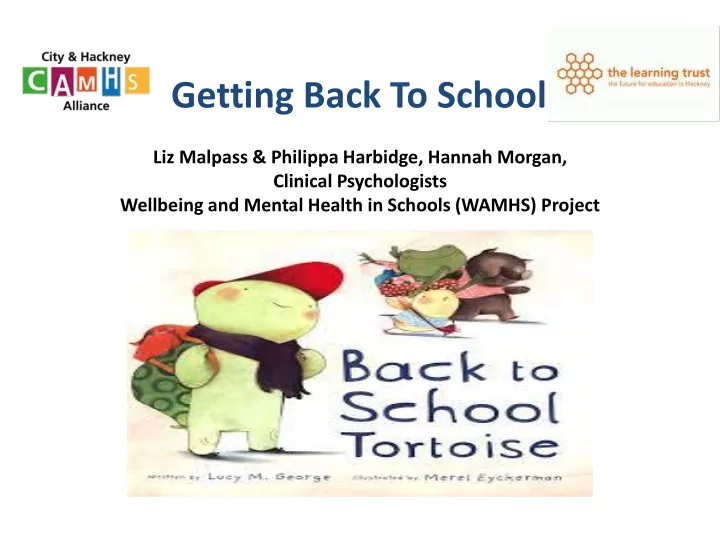

Getting Back To School! Liz Malpass & Philippa Harbidge, Hannah Morgan, Clinical Psychologists Wellbeing and Mental Health in Schools (WAMHS) Project
Everybody’s Experience is Different • “We all know that Hackney is special. It’s a place where we celebrate diversity and people from different perspectives and backgrounds get along with each other. It’s one of things I’m most proud about as Mayor… We need to remember that we’re all living very different versions of lockdown, and our experiences and challenges vary wildly. We need to show each other respect, be understanding of each other’s circumstances…” (Philip Glanville).
What We Will Cover Feelings About Going Back “I feel excited to be getting back to school” “I feel worried that my child may not manage the transition back to school” Relationships “I’m really excited to see my friends and my teacher again” “I’m looking forward to getting more structure back to our family life” “We lost two grandparents and I am worried about how it will feel for my child to return to school, they were very close” Behaviour “I’m looking forward to getting more structure back to our family life” “My child’s behaviour has deteriorated over lockdown, I’m worried about the return to school.”
Understanding Emotions
The Threat System • Enables us to detect any possible threat and prepares our body to respond • Involves the emotions of anger and anxiety • Operates on a ‘better safe than sorry policy’
The Drive System • Give us positive feelings that guide and motivate us to seek out resources. • Involves the emotions of wanting, pursuing, excitement and pleasure. • Is incentive and reward seeking
The Soothing System • Enables us to feel calm, safe, connected, content. • Is connected to our attachments – our relationships and feelings of safety and belonging. • Helps regulate feelings of threat (anger, anxiety) or drive (excitement, reward) keeping the three systems in balance.
Example 1 Drive System Soothing System Threat System
Example 2 Soothing Drive System System Threat System
How would draw your three circles? Draw Your Three circles Draw Your Childs Three Circles
Managing The Threat System • Its normal to feel stressed and apprehensive by the transition back to school. • We need to allow time for these big adjustments to be made. • Reflect back upon previous transitions – What was helpful for your child then? • The main way that we can manage feelings of threat is through building up our soothing system.
Building Safety and Connection • Have a routine • Talk to children about the routine – especially if things have changed for your family during lockdown. Who will pick you up? who will be at home on what days? etc. • Prioritise quality time with your child – play, connection and family time. • Reconnect and re-establish relationships
Calm Down Activities • Mindful Breathing. • Safe Space
Building Up your Soothing System as a Parent • Relaxation • Talking to a friend • Having time to yourself • Trying to get good sleep • Having a bath • Exercise • Going for a walk • Remember to breath • Being compassionate to yourself - Allow yourself to find this time difficult
Validating Worries and Fears • Feeling reassured yourself. • Talking about worries and fears. • Validating emotions but not necessarily agreeing with the worry as fact. • Worries versus problems • Problem solving and coping strategies
Understanding Behaviours Difficult behaviours What system is my child in? (Threat, Drive, Soothing?) What system am I in? What might my child need from me in this moment?
Managing The Drive System • Motivation - Building enthusiasm and excitement. • Conversations about what children are looking forward to... • Establishing Routine again – Boundaries.
Summary
Getting more help • Inevitably some children and young people will find this situation more difficult to deal with than others • If you are concerned about your child’s emotional well -being or mental health, discuss with your child’s class teacher, your GP, other health professional, or see CAMHS and council websites
Thank you! Please see your resources list for extra worksheets, exercises and information.
Recommend
More recommend